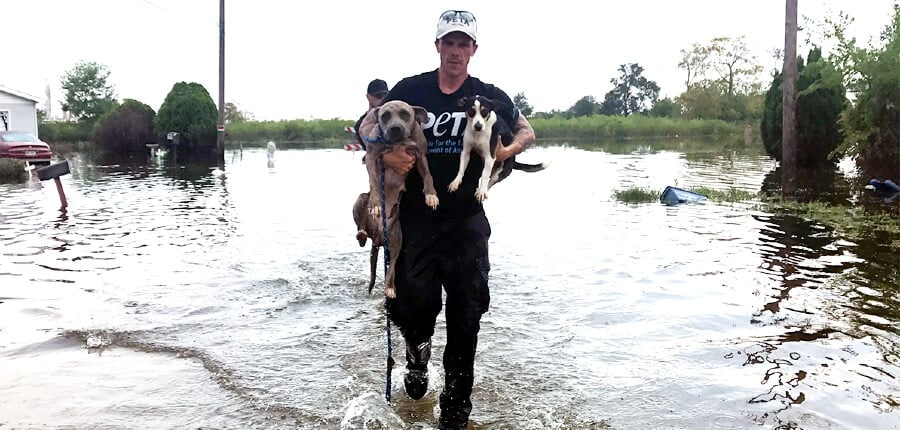Kittens clinging to the top of a patio umbrella surrounded by rising floodwaters. A dog balancing on a floating bookshelf. Chihuahuas stuck under a collapsed house. Chickens trapped in submerged coops. A dog whose paws were badly burned. These are just a few of the animals PETA fieldworkers have rescued just in the nick of time following natural disasters. Others weren’t so lucky.
We know the dangers. So why, in an emergency, are animal companions so often left behind?
The problem seems to be twofold. First, many evacuation workers and shelters refuse to accept animals, leaving their guardians in a no-win situation. And second, guardians are often unprepared when disaster strikes. But there are solutions.
When Hurricane Katrina pummeled the Gulf Coast, about 44% of New Orleans residents refused to follow evacuation orders, in many instances because the Superdome and other shelters had “no animals” policies. Some residents were threatened with arrest and forced to comply, and some took the dangerous step of reentering the evacuation zone to try to rescue their animals. As a result of Katrina’s heart-wrenching devastation, Congress passed the Pets Evacuation and Transportation Standards Act of 2006, requiring states that receive FEMA aid to include animals in their evacuation and sheltering plans. Since then, more than 30 states have enacted emergency protection protocols for animals or have plans in the works. Not all evacuation shelters have to accept animals, but options must be provided.
For guardians, it comes down to finding them. And the best time to do that is well in advance of an emergency. Having a plan in place will ensure that the entire family can stay together safely. A quick call to your county emergency management office or local animal shelter may be all it takes to find a list of animal-friendly sheltering options in your area. A simple online search for “animal-friendly evacuation shelters near me” also returns numerous results. In the event that there are no facilities nearby, campgrounds can be a good option, and many hotels that normally don’t allow animals often lift their prohibitions during natural disasters. A few minutes on the phone should yield a solid list.
If you’re required to leave the area, animals are always safer with you than they would be if left behind to fend for themselves. Having a “go bag” ready for them can save precious time when disaster strikes. It should include a harness and leash or a carrier; bowls; medical records; litter and a small litter tray for cats; a favorite toy or blanket; and enough food, bottled water and medication to last at least a week. All animals should be microchipped and wearing current identification tags.
National Preparedness Month presents the perfect opportunity to make a plan to ensure our animal companions’ safety during emergencies. With the climate catastrophe causing natural disasters to become more frequent, there is no time to waste. Our best friends help us weather every storm, and we should do the same for them.





